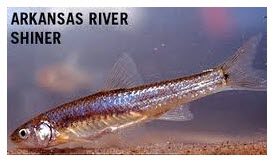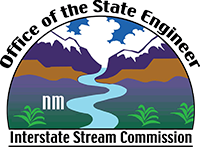Interstate Stream Commission
- OSE Home
- About ISC
- Basins
- Canadian River Basin
- Endangered Species
Canadian River Basin - Endangered Species
The Arkansas River Shiner was first listed on November 23, 1998. It is currently designated as Threatened in the Arkansas River Basin (AR, KS, NM, OK, TX). Within the area covered by this listing, this species occurs in: Arkansas, Kansas, New Mexico, Oklahoma, and Texas. The U.S. Fish and Wildlife Service Southwest Region (Region 2) is the lead region for this entity.
SPECIES DESCRIPTION
The Arkansas River shiner is a small minnow  with a flat head, round snout, and small mouth. Adults attain a maximum length of 8 cm. Dorsal, anal, and pelvic fins all have eight rays, and there is usually a small, black chevron present at the base of the caudal fin. Dorsal coloration tends to be light tan, with silvery sides gradually grading to white on the belly.
with a flat head, round snout, and small mouth. Adults attain a maximum length of 8 cm. Dorsal, anal, and pelvic fins all have eight rays, and there is usually a small, black chevron present at the base of the caudal fin. Dorsal coloration tends to be light tan, with silvery sides gradually grading to white on the belly.
REPRODUCTION AND DEVELOPMENT
The Arkansas River shiner spawns between June and July, and spawning may also occur in August, after water flow increases. Spawning takes place in the mainstream channel, where eggs may travel many miles downstream before hatching. Eggs will hatch within 24-48 hours, and larvae can swim up to 4 days before seeking backwater pools and side channels where food is more abundant (Moore 1944).
Arkansas River Shiner Notropis girardi - Species Description: Source: U.S. Fish & Wildlife
Management Plan to Benefit Arkansas River Shiner
In March 2005, the Canadian River Municipal Water Authority issued a proposed management plan to benefit the Arkansas River shiner, which is designated as a threatened species under the U. S. Endangered Species Act. The minnow which lives in the streams of the Arkansas River basin, including the Canadian River, has created concern for those who depend upon the Canadian for their water supply, and recreation activities and those who own property adjacent to the stream.
The intent of this effort is to provide benefits that will aid in conservation and recovery of the species, while avoiding unnecessary and restrictive regulation of activities in the proposed area of critical habitat and upstream areas which could be affected by the designation of critical habitat.
